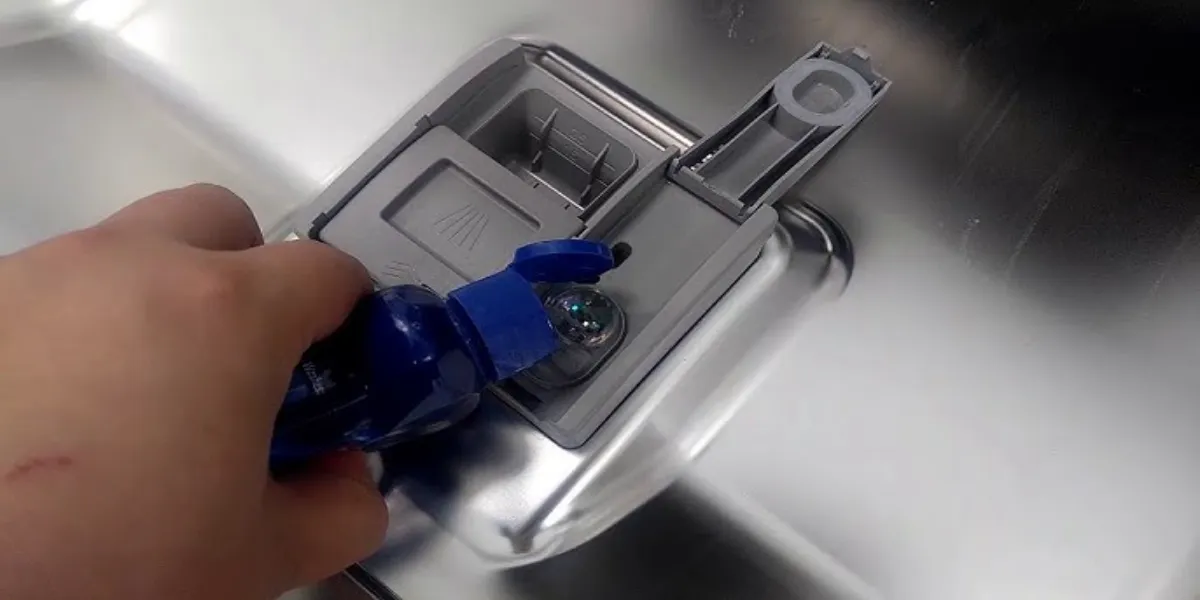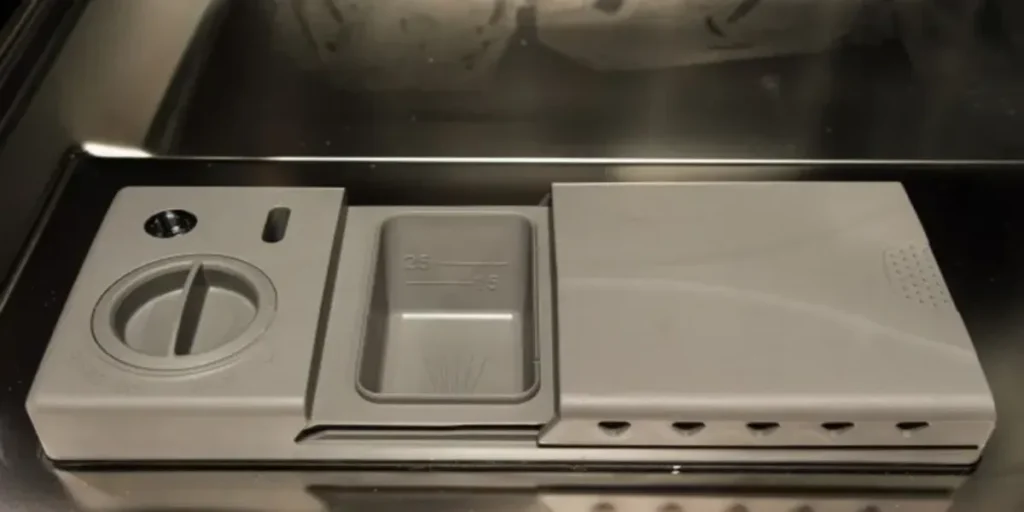Is your Bosch dishwasher’s rinse aid leaving you with less-than-sparkling dishes?
Learn how to tackle the frustration head-on as we uncover the common glitches causing your rinse aid to malfunction.
In this article, you’ll uncover practical solutions to revive the shine in your dishwashing routine. We’ll get your Bosch dishwasher back to its best – no more water spots!

Common Bosch Dishwasher Rinse Aid Issues
There are various issues that can affect your rinse aid mechanism and cause it to malfunction or fail. Some of them are:
Dispenser Problems
This is when the rinse aid dispenser does not release the right amount of rinse aid or does not release it at all. This can be due to a clogged, broken, or leaking dispenser.
A clogged dispenser may prevent the rinse aid from flowing out of the reservoir.
A broken dispenser may have faulty components such as springs, valves, or sensors that prevent it from opening or closing properly.
A leaking dispenser may spill the rinse aid inside the dishwasher door or on the floor.
Inadequate Drying
This is when the dishes do not dry completely or evenly after the wash cycle. This can be due to low or high rinse aid settings, hard water, or insufficient heat.
Low rinse aid settings may not provide enough rinse aid to coat the dishes and help them dry faster. Using a high rinse aid setting may result in too much rinse aid remaining on the dishes.
Minerals in hard water may interfere with the rinse aid’s effectiveness and leave spots or residues. Insufficient heat may prevent the dishes from evaporating the water and rinse aid from their surface.
Water Spots and Residue
This is when the dishes have water spots, streaks, film, or residue on them after the wash cycle. This can be due to expired or poor quality rinse aid, incorrect dosage, or incompatible detergent.
Rinse aids that are expired or of poor quality may leave behind soap traces or food particles. Too little or too much rinse aid may affect the cleaning and drying performance of the wash cycle.
Incompatible detergent may react with the rinse aid and form a cloudy or sticky substance on the dishes.
Error Messages
Error messages appear on the control panel when the rinse aid mechanism is malfunctioning.
For example, E15 means there is a leak in the dishwasher that may be caused by a faulty rinse aid dispenser.
E22 means there is a problem with the filter system that may be clogged by excess rinse aid. These error messages can help you identify the source of the problem and take appropriate action.
Low Rinse Aid Indicator
This is when the control panel shows a low rinse aid indicator that tells you to refill the rinse aid reservoir.
This indicator may be a light, a symbol, or a message on the display screen. It usually appears when the rinse aid level is below 25%.
You should refill the rinse aid reservoir as soon as possible to avoid running out of it during a wash cycle.
Compatibility Concerns
This is when the rinse aid you use is not compatible with your Bosch dishwasher model or features.
A Bosch dishwasher with AutoAir allows steam to escape and improve drying at the end of the cycle. Some rinse aids that create a thin film on the dishes may not work well with this feature.
If you are not sure which rinse aid is right for your dishwasher model, contact Bosch customer service.
Environmental Factors
A rinse aid’s performance can be affected by external factors like temperature, humidity, and altitude.
For example, high temperature or humidity may cause the rinse aid to evaporate faster or form condensation on the dishes.
Low temperature or altitude may affect the viscosity or flow rate of the rinse aid. You should adjust your rinse aid settings or dosage according to the environmental conditions in your area.
Signs Your Rinse Aid is Not Functioning Properly

You may notice some signs that your rinse aid is not working if you have any of the issues listed above. Some of them are:
Streaky Dishes
This is when the dishes have streaks or lines on them after the wash cycle. This can be caused by too much rinse aid being used or remaining on the dishes.
The excess rinse aid may not be rinsed off properly and may dry on the dishes, leaving visible marks.
Soap Residues
This is when the dishes have soap residues or bubbles on them after the wash cycle. This can be caused by too little rinse aid being used or not working effectively.
The insufficient rinse aid may not be able to remove all the soap or food particles from the dishes, leaving behind a sticky or greasy substance.
Spotty Glassware
This is when the glassware has spots or stains on it after the wash cycle. This can be caused by hard water, expired or poor quality rinse aid, or incorrect dosage.
The hard water may contain minerals that react with the rinse aid and form deposits on the glassware. The expired or poor quality rinse aid may not be able to prevent water spots and mineral deposits from forming on the glassware.
The incorrect dosage may cause too little or too much rinse aid to be used for the wash cycle and affect the cleaning and drying performance.
How to Troubleshoot and Fix Rinse Aid Issues?

Here are some ways to troubleshoot and fix rinse aid issues.
Regularly Check and Clean the Dispenser
To maintain optimal performance, routinely inspect and clean the dispenser. Turn off and unplug the dishwasher.
Locate the dispenser inside the door, marked with a water drop or star symbol. Open the cap, examine for dirt, debris, or soap residue, and clean using a cloth or brush.
Use a toothpick or cotton swab for hard-to-reach spots. Rinse and dry the dispenser and cap, then close it securely.
Plug in the dishwasher and power it on for improved dispenser functionality.
Replace Expired Rinse Aid
Expired rinse aids can lead to subpar results. Check the expiration date on the bottle or label, and replace it if expired.
Open the dispenser cap, empty the old rinse aid, and fill it with new liquid, respecting the “Full” indicator. Wipe any spills with a damp cloth.
Close the cap tightly, ensuring the new rinse aid enhances your dishwasher’s performance.
Reset and Configure Correct Settings
Reset and configure dishwasher settings for improved rinse aid performance. Consult the user manual or Bosch website for model-specific recommendations.
Turn off and unplug the dishwasher. Open the door, locate the control panel, and press and hold the A button and Start button until “0:01” appears.
Wait for “0:00” to indicate reset completion. Adjust settings based on instructions. Plug in and power on the dishwasher to enjoy optimal settings.
Inspect for Blockages
Debris can obstruct rinse aid flow from the dispenser. Check for dirt, debris, or residues in the dispenser. Clean it using a soft cloth with mild soap and water.
Reach tight spots with a toothbrush or cotton swab. Rinse and dry the dispenser before closing the cap securely.
Consider External Water Softeners
In areas with hard water, an external water softener can improve rinse aid efficiency. Consult your user manual or Bosch website for suitable softener recommendations.
Purchase and install the softener following the manufacturer’s instructions. Fill the softener with recommended agents and adjust rinse aid settings accordingly for optimal results.
This integration enhances rinse aid performance, preventing spots and residues on your dishes.
FAQ About Bosch Dishwasher Rinse Aid Issues
How often should I refill the rinse aid in my Bosch dishwasher?
Refill the rinse aid reservoir when the indicator shows it’s low, usually around 25% capacity.
Does the brand of rinse aid make a difference in performance?
Yes, using a recommended brand of rinse aid can enhance performance and prevent issues.
Is it okay to use a substitute for a rinse aid?
It’s best to use a proper rinse aid as substitutes might not provide the same results and could lead to problems.
Can using too much rinse aid harm my dishwasher?
Using excessive rinse aid can lead to issues like streaks, residues, or dispenser malfunctions.
How do I know if the rinse aid dispenser is malfunctioning?
Malfunctions might include inconsistent releases, leaks, or error codes on the control panel.
Conclusion
Bosch dishwasher rinse aid malfunction raises questions about its performance and effectiveness.
Addressing this issue is essential to ensure optimal cleaning results and to maintain the appliance’s efficiency.
The dishwasher’s functionality can be restored with prompt troubleshooting and potential technical support.
